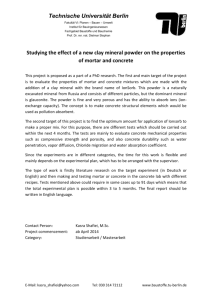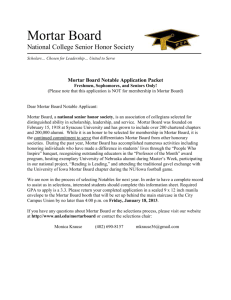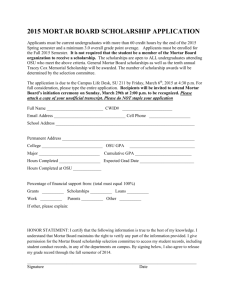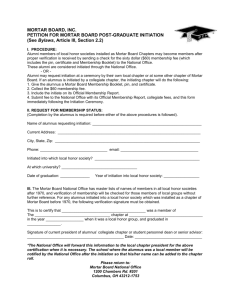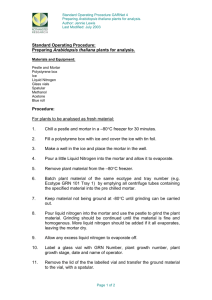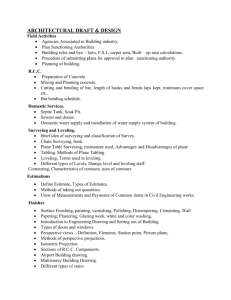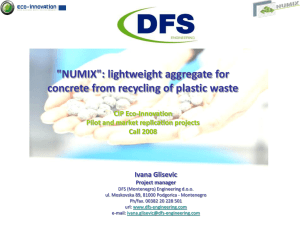item 520 pneumatically placed mortar
advertisement
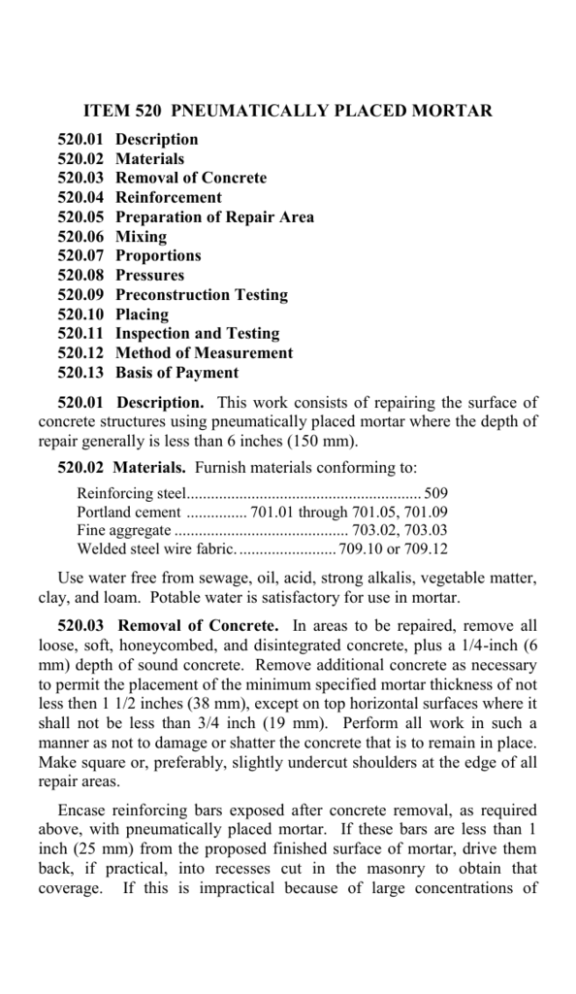
ITEM 520 PNEUMATICALLY PLACED MORTAR 520.01 520.02 520.03 520.04 520.05 520.06 520.07 520.08 520.09 520.10 520.11 520.12 520.13 Description Materials Removal of Concrete Reinforcement Preparation of Repair Area Mixing Proportions Pressures Preconstruction Testing Placing Inspection and Testing Method of Measurement Basis of Payment 520.01 Description. This work consists of repairing the surface of concrete structures using pneumatically placed mortar where the depth of repair generally is less than 6 inches (150 mm). 520.02 Materials. Furnish materials conforming to: Reinforcing steel.......................................................... 509 Portland cement ............... 701.01 through 701.05, 701.09 Fine aggregate ........................................... 703.02, 703.03 Welded steel wire fabric. ........................ 709.10 or 709.12 Use water free from sewage, oil, acid, strong alkalis, vegetable matter, clay, and loam. Potable water is satisfactory for use in mortar. 520.03 Removal of Concrete. In areas to be repaired, remove all loose, soft, honeycombed, and disintegrated concrete, plus a 1/4-inch (6 mm) depth of sound concrete. Remove additional concrete as necessary to permit the placement of the minimum specified mortar thickness of not less then 1 1/2 inches (38 mm), except on top horizontal surfaces where it shall not be less than 3/4 inch (19 mm). Perform all work in such a manner as not to damage or shatter the concrete that is to remain in place. Make square or, preferably, slightly undercut shoulders at the edge of all repair areas. Encase reinforcing bars exposed after concrete removal, as required above, with pneumatically placed mortar. If these bars are less than 1 inch (25 mm) from the proposed finished surface of mortar, drive them back, if practical, into recesses cut in the masonry to obtain that coverage. If this is impractical because of large concentrations of reinforcing bars, provide the minimum specified mortar coverage by modifying the finish surface as the Engineer approves. If the bond between the concrete and a primary reinforcing bar has been destroyed, or if more than one-half of the periphery of a bar has been exposed, remove the adjacent concrete to a depth that will provide a minimum 3/4-inch (19 mm) clearance around the bar, except where other reinforcing bars make this clearance impractical. Adequately support reinforcing that has become loose, and tie it back into place. Replace reinforcement that is damaged during construction operations. Only use pneumatic or hand tools that give results satisfactory to the Engineer in the removal of concrete and in preparing and shaping the areas to be repaired. If working around reinforcing steel, avoid loosening the steel, or shattering the concrete around it, beyond the repair area. 520.04 Reinforcement. If pneumatically placed mortar is specified to repair areas of unsatisfactory concrete, or for surface coverage of exposed reinforcing steel, place wire fabric in all areas where the thickness of the mortar patch is 1 1/2 inches (38 mm) or more. For areas where the thickness of the mortar patch exceeds 4 inches (100 mm), use a single layer of wire fabric to reinforce each 4-inch (100 mm) thickness of patch or fractional part thereof. Use fabric that is either 2 2 inches (50 50 mm) using wire size number W 0.9, or 3 3 inches (75 75 mm) using wire size number W 1.4. Place all fabric parallel to the proposed finished surface. Completely encase each layer of fabric in mortar that has taken its initial set before the succeeding layer of fabric is applied. Ensure that fabric supported adjacent to the prepared masonry surface is no closer than 1/2 inch (13 mm) to that surface. Overlap adjacent sheets of fabric by 6 inches (150 mm), and securely tie them together. Carefully pre-bend fabric before installation to fit around corners and into reentrant angles. Never spring fabric into place. Place all steel items, including reinforcing bars and wire fabric, no closer than 1 inch (25 mm) to the proposed finished surface of mortar. Support wire fabric with anchor bolts except where existing reinforcing steel in the repair area is considered by the Engineer to be satisfactory for this purpose. Construct anchors of 1/4-inch (6 mm) minimum diameter expansion hook bolts, and ensure that each bolt has sufficient engagement in sound masonry. For repairs that are generally 4 inches (100 mm) thick or less, space anchors no more than 12 inches (0.3 m) and 18 inches (0.5 m), center-to-center, on overhead and vertical surfaces, respectively, and 36 inches (1.0 m), center-to-center, on top horizontal surfaces. For repairs that exceed 4 inches (100 mm) in thickness, ensure that the anchor bolts are capable of supporting three times the weight of suspended mortar and two times the weight of mortar on vertical surfaces. Use at least three anchors for each patch. If specified, thoroughly clean reinforcing exposed in the original structure, or exposed after removals as required above, and restore any appreciable reduction in steel area as directed. 520.05 Preparation of Repair Area. After removing all unsatisfactory concrete, properly shaping the sound concrete surface, placing dowels and expansion hook bolts, and restoring steel area as directed, and within 24 hours before placing the mortar, blast clean all surfaces to which the mortar is to bond, including exposed reinforcing steel, existing concrete, and the work face of any previously placed mortar, to remove all spalls, laitance, and contaminants detrimental to the achievement of an adequate bond. The Contractor may blast clean these surfaces using high-pressure water blasting with or without abrasives in the water, abrasive blasting with containment, or vacuum abrasive blasting. If a bonding compound is not specified, drench the prepared masonry surface with water and keep the prepared surface wet during the 2 hours preceding the placement of the mortar. Ensure that all surfaces are damp, but without free water, while placing mortar. The Engineer will approve the preparation and condition of all surfaces immediately before the application of the mortar. 520.06 Mixing. Thoroughly dry mix the materials in a batch mixer. Before placing the mixture in the hopper of the cement gun, remove all materials and lumps over 1/4 inch (6 mm) in size by screening. Apply the screened sand and cement to the masonry surface within 1 hour after being combined. 520.07 Proportions. Ensure that the mixture as placed in the hopper has a ratio of one volume of portland cement to three volumes of sand. 520.08 Pressures. Use at least 35 pounds per square inch (240 kPa) pneumatic pressure at the cement gun in placing the mixed material. If more than 100 feet (30 m) of hose or a greater lift than 25 feet (7.5 m) is used, increase the pressure proportionately. Maintain the water at a uniform pressure of not less than 25 pounds per square inch (170 kPa) above the pressure of the air on the gage at the cement gun. 520.09 Preconstruction Testing. Before the start of placing any mortar, perform a preconstruction test to verify the operation of the equipment, to confirm the application crew’s capability, and to ensure the pneumatically placed mortar will be of acceptable quality. Fabricate the test panel by gunning mortar onto the plywood bottom of an open box 4-foot (1.2 m) square and 4 inches (100 mm) deep. Install reinforcement in the test panel that matches the largest size and tightest spacing found for the reinforcement in the bridge. Mount the box vertically and apply the mortar using the same personnel, equipment, and procedures that will be used on the project, until the box is full. Adjust the mixing water to provide mortar of the proper consistency, but do not exceed a total water content, including the free moisture in the aggregate and water added at the nozzle, of 4.5 gallons (17 L) per sack of cement (94 pounds = 42.6 kg). Take three cores from the test panel, and test them for compressive strength at an independent testing laboratory. Ensure that the strength at 28 days is a minimum of 4200 pounds per square inch (29.5 MPa) or at a minimum compressive strength of 3200 pounds per square inch (22.5 MPa) at 7 days. After taking the cores, break the test panel and allow the Engineer to carefully examine the interior portions. Ensure that they are substantially free of hollow areas and sand pockets, and ensure that the mortar is well bonded to the reinforcement. Have each crew proposed to perform this work fabricate a satisfactory panel before allowing that crew to apply mortar to the structure. 520.10 Placing. Place the premixed dry cement and sand by pneumatic equipment with the proper amount of water applied in the mixing nozzle for the correct placement consistency. Apply the mortar as dry as practical to prevent shrinkage cracking. Use shooting strips to ensure square corners, straight lines, and a plane surface of mortar, except as otherwise permitted by the plans or approved by the Engineer. Place shooting strips so as to keep the trapping of rebound at a minimum. At the end of each day’s work, or similar stopping periods requiring construction joints, slope the mortar off to a thin edge. In shooting all surfaces, ensure that the stream of flowing material from the nozzle impinges as nearly as possible at right angles to the surface being covered, and hold the nozzle 2 to 4 feet (0.6 to 1.2 m) from the working surface. Apply a sufficient number of mortar coats to obtain the required thickness. Finish mortar repairs flush with the original masonry surface, except as noted for areas of exposed reinforcing steel. On vertical and overhead surfaces, do not apply any coat thicker than 1 inch (25 mm), except as the Engineer approves, and place each coat so that it will neither sag nor decrease the bond of the preceding coat. If a successive coat is applied on mortar that has set for more than 2 hours, clean and dampen the mortar surface as required in 520.05 for the prepared masonry surface. Remove deposits of rebound from previous shooting, whether loose or cemented. After mortar has been placed to the desired thickness, cut off all high spots with a sharp trowel, or screed them to a true plane as determined by shooting strips or by the original masonry surface, or as directed. If using screeds, apply them lightly to all surfaces so as not to disturb the mortar for an appreciable depth, and work them in an upward direction when applied on vertical surfaces. Unless otherwise directed, give the finished mortar surface a flash coat about 1/8 inch (3 mm) thick. Take special care to obtain a sightly appearance on all exposed surfaces. Cover the pneumatically placed mortar patches with burlap or cotton mats, and keep them wet for 7 days after placing. If it is not practical to use mats, keep the surface wet by sprinkling for the same length of time. If the Engineer determines that the above curing procedures are impractical because of the inaccessibility of isolated repair areas, the Contractor may cure the final mortar surface according to 511.17, Method B. Do not place pneumatically placed mortar when the air temperature is below 50 F (10 C) or against a surface in which there remains any frost. Protect all mortar against cold weather according to 511.15. 520.11 Inspection and Testing. After curing and before final acceptance, sound all patched areas. Remove and replace all unsound or cracked areas. In addition to sounding all patches, the Department will base acceptance of the pneumatically placed mortar on 4-inch (100 mm) diameter cores taken from patched areas and tested for compressive strength. The Engineer will determine the location of the cores, with one core being taken for each 200 square feet (20 m 2) of pneumatically placed mortar. Drill the cores completely through the patched area and into the underlying sound concrete at least 1/2 inches. Ensure that the depth of the cores is at least 4 inches. The Engineer will visually inspect the cores at the site for hollow areas, sand pockets, and voids around reinforcing steel. Test the cores at an independent laboratory for compressive strength. The required minimum average compressive strength is 3000 pounds per square inch (21 MPa) at 7 days, with no single core test less than 2600 pounds per square inch (18 Mpa). The Engineer will waive coring on small quantities or overhead patches if it is determined by sounding and visual inspection that the patches are sound. Remove, replace, re-inspect, and re-test all defective patches, as determined by sounding, visible cracks, or unacceptable cores. Fill core holes with concrete as per 519. 520.12 Method of Measurement. The Department will measure Pneumatically Placed Mortar by the number of square feet (square meters) as determined under Method A, unless Method B or another method is specified. A. Method A. The Department will measure the actual area of exposed surfaces of all completed, tested, and approved patches, irrespective of depth or thickness of the patch. If a patch includes corners or edges of such members as beams, columns, or curbs, the Department will include all of the exposed surfaces; or if a patch extends completely through a member or a slab, the Department will include both exposed surfaces. B. Method B. For unreinforced mortar repairs, the Department will measure the actual area of exposed surfaces of all completed, tested, and approved patches, irrespective of depth or thickness of patch. If a patch includes corners, or edges of such members as beams, columns, or curbs, the Department will include all of the exposed surfaces. For fabric reinforced mortar repairs, the Department will measure the actual surface area of fabric, complete and in place. The Department will consider fabric laps and layers of fabric closer than 2 1/2 inches (65 mm), centerto-center of layer, as a single layer in area measurements. The Contractor and the Engineer will agree on the measured area of wire fabric before said fabric is encased in mortar, otherwise the Department will obtain the area of the patch for pay purposes as described for unreinforced mortar repairs. The Contractor is responsible for all test panels, coring repair of core holes, independent laboratory testing of the cores, and replacement of rejected areas and shall include them under Pneumatically Placed Mortar. 520.13 Basis of Payment. The Department will not pay for additional reinforcement to replace that damaged by the Contractor’s operations. The Department will not pay for removing, replacing, and reinspecting of defective patched mortar as determined by sounding, visible cracks, or unacceptable cores. The Department will pay for accepted quantities at the contract price as follows: Item Unit Description 520 Square Foot (Square Meter) Pneumatically Placed Mortar
